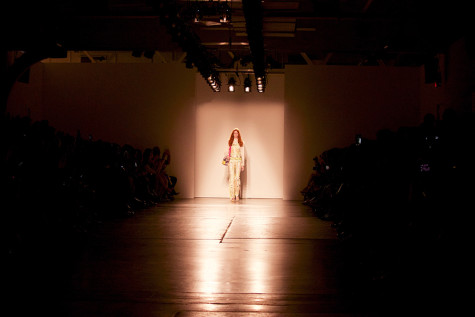The Evolution of Fashion Week
September 21, 2015

Custo Barcelona at New York Fashion Week.
Only one event has New York buzzing with an influx of models, sartorial street style and an economic impact of $865 million each year: New York Fashion Week. While France may be able to boast that it originated fashion parades in which haute couture salons showcased their wares, it is New York City that claims the title as birthplace of is the runway show.
The 1903 Ehrlich Brothers’ fashion show is commonly believed to be the world’s first fashion runway show. Friendly competition against the Parisians prompted Eleanor Lambert, a prominent fashion publicist, to organize a so-called “Fashion Press Week” in 1943 New York, the earliest predecessor to the current NYFW. This event allowed designers to display their collections to journalists and editors. Fashion magazines that once predominantly featured European designers, such as Vogue, began to feature more American designs.
Continuing from Lambert’s first week of shows in the early ’40s, NYFW has since transformed into a city-wide event. After countless relocating and renaming, from “7th on Sixth” at Bryant Park to “Mercedes-Benz Fashion Week” at Lincoln Center, the week has now evolved into a decentralized schedule of events, aptly titled “New York Fashion Week: the Shows.”
However, the technical and logistical changes of NYFW were not the only alterations. The overall purpose and tone of NYFW seems to have changed. Fashion week was once was an exclusive, invite-only event for industry insiders. However, with the advent of the Internet and social media, everyone can now be part of the audience.
The year 2009 was the watershed year for livestreaming Fashion Week, with Alexander McQueen livestreaming its Spring/Summer 2010 show. Others in the fashion industry quickly followed suit, with Louis Vuitton, Alexander Wang, Marc Jacobs and Burberry also streaming their runway shows. In 2015, it is no longer just the business elite who watch these shows.
While 100,000 people attended Fashion Week 2014, 2.6 million people livestreamed the shows, watching Fashion Week from the comfort of their own screens. Guest lists still exist; however, they are now nearing irrelevance. Why trek out in the rain if you can see the best show, and probably have a better view, if you stay at home and stream the show? You can live in Kansas, Taipei, New York — anywhere you have access to your preferred Internet platform, and have access to Fashion Week and the newest collections.
This year’s hottest show, Givenchy, opened its doors to the public but with a catch. Creative director Riccardo Tisci allowed 820 lucky members of the public to win coveted tickets to his 10th anniversary show for the legendary French house. While there was a separate entrance for the public, there was a precedent set: the exclusivity of Fashion Week is changing. If a haute couture house has allowed the public into its show, what’s next?
Fashion has become a more egalitarian, collaborative process; however, not everyone is happy with this evolution of NYFW. In 2013, New York Times reporter Eric Wilson said, “The real point of Fashion Week, to promote collections to editors and retailers … is becoming lost in the age of instant online accessibility … Fashion Week is losing its relevance.”
While the changing guest list may seem to make Fashion Week extraneous, the overall meaning of Fashion Week is changing to combat this. Fashion Week has become a public platform for social justice and artistic statements alongside being an excellent marketing and publicity event. Everyone watched in awe as Riccardo Tisci and Marina Abromavic’s hauntingly memorable runway show exhibited Tisci’s works of visual art with Abromavic’s passionate performance tableaus on Sept. 11.
Designer Kerby Jean-Raymond’s Spring/Summer 2016 NYFW runway show combined video, clothing and live art to protest police brutality. A 10-minute video depicted the killing of Walter Scott, the unarmed man shot by police officers in South Carolina. Immediately following the Scott footage, Jean-Raymond presented footage of the Texas teens terrorized by police this summer. This powerful display ended with Eric Garner’s infamous last words “I can’t breathe.” The collection furthered Jean-Raymond’s protest against America’s codification of racism; gunshots replaced bass drops, models strutted while splattered in blood and Eric Garner’s “I can’t breathe” was hand-graffitied on-site on each shoe.
From its origins in the early 20th century, NYFW has continued to evolve, reflecting the styles we as a society find captivating. It is in this sustained growth that the city-wide event and its runway shows are again finding their role as a space of even more reflection for society.
Email Linda Yang at [email protected].
